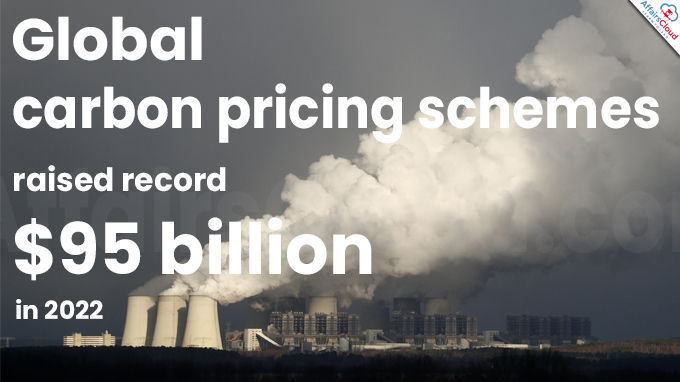 According to the World Bank’s (WB) annual report ‘State and Trends of Carbon Pricing 2023’ released on May 23, 2023, revenues collected from carbon taxes and Emissions Trading Systems (ETS) globally have reached a record high, about US$95 billion in 2022 despite the challenging context for governments facing high inflation, fiscal pressures, and energy crises.
According to the World Bank’s (WB) annual report ‘State and Trends of Carbon Pricing 2023’ released on May 23, 2023, revenues collected from carbon taxes and Emissions Trading Systems (ETS) globally have reached a record high, about US$95 billion in 2022 despite the challenging context for governments facing high inflation, fiscal pressures, and energy crises.
- The revenues collected from carbon taxes and ETS in 2021 was about US$ 84 billion.
- The report was launched at Innovate4Climate (I4C), the World Bank Group’s flagship climate action event which held in Bilbao, Spain, from May 23 to 25 2023.
Carbon Pricing Instruments:
i.As per the report, there are currently 73 global carbon pricing instruments are in operation, compared with 68 in May 2022 when the World Bank issued its 2022 report.
ii.The 73 Carbon Pricing initiatives covered 11.66 GtCO2e (gigatonnes of carbon dioxide equivalent), representing 23% of global greenhouse gas (GHG) emissions
- Only 7% of global GHG emissions were covered by either a carbon tax or an ETS, when the report was published for first time i.e. 10 years ago.
- As of April 1, 2023 less than 5% of global GHG emissions are covered by a direct carbon price at or above the range recommended by 2030.
iii.New instruments were implemented in Austria and Indonesia, as well as in subnational jurisdictions in the United States and Mexico.
Carbon Price:
i.In 2017, a report by the High-Level Commission on Carbon Prices indicated the need for carbon prices need to be in the USD 50-100 per ton range by 2030 to keep a rise in global temperatures below 2 degrees Celsius, the upper end of the limit agreed upon in the 2015 Paris agreement.
ii.As per the ‘State and Trends of Carbon Pricing 2023’ report, being adjusted for inflation, the carbon price were now needed to be in a range of USD 61-122 per ton.
What is Carbon Pricing?
It is an instrument that captures the external costs of GHG emissions. It is the costs of emissions that the public pays for, such as damage to crops, health care costs from heat waves and droughts, and loss of property from flooding and sea level rise and ties them to their sources through a price, usually in the form of a price on the carbon dioxide (CO2) emitted.
Types of Carbon Pricing
There are two main types of carbon pricing: emissions trading systems (ETS) and carbon taxes.
i.ETS: It referred to as a cap-and-trade system, that caps the total level of GHG emissions and allows those industries with low emissions to sell their extra allowances to larger emitters.
- By creating supply and demand for emissions allowances, an ETS establishes a market price for GHG emissions.
- The cap helps ensure that the required emission reductions will take place to keep the emitters (in aggregate) within their pre-allocated carbon budget.
ii.A carbon tax: This is a tax that directly sets a price on carbon by defining a tax rate on greenhouse gas emissions or – more commonly – on the carbon content of fossil fuels. It is different from an ETS in that the emission reduction outcome of a carbon tax is not pre-defined but the carbon price is.
Note – The report states that Chile, Malaysia, Vietnam, Thailand and Türkiye continue to work towards implementing direct carbon pricing.
Recent Related News:
On November 14, 2022, the Climate Change Performance Index (CCPI) 2023 released which was published by three environmental non-governmental organizations viz. Germanwatch, NewClimate Institute and the Climate Action Network (CAN) International. In this, India climbed two spots to bag 8th position out of 63 with a score of 67.35, and achieved ‘High’ performance rating.
About World Bank (WB):
Headquarters – Washington, DC, USA
Establishment – 1944
World Bank Group President – David Malpass (Ajay Banga will take over as President of WB on 2nd June 2023)




